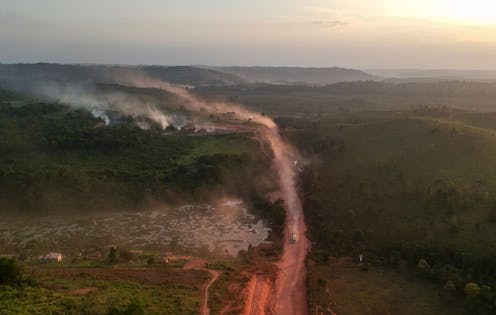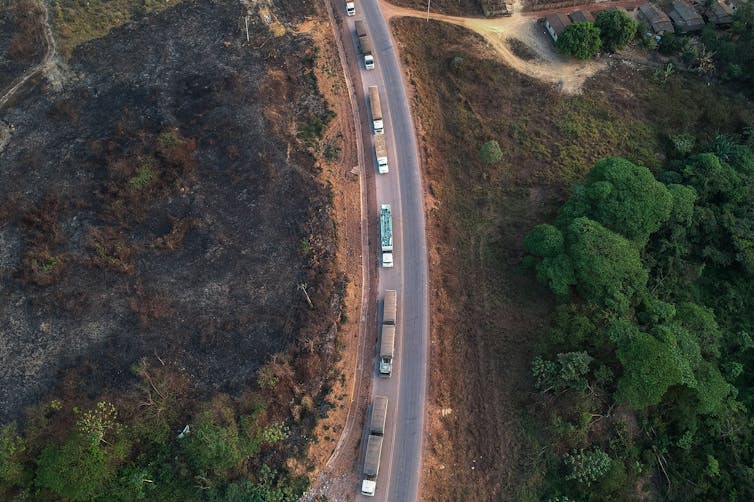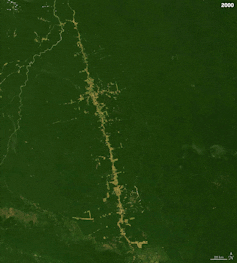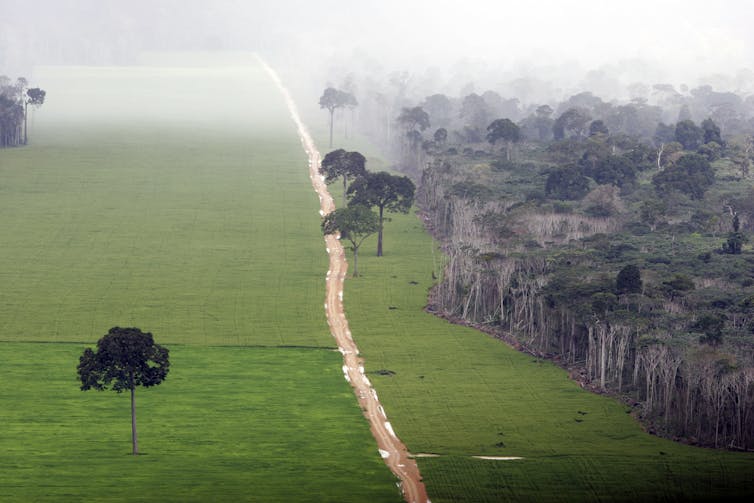The Amazon is not safe under Brazil's new president – a roads plan could push it past its breaking p
Nearly 95% of deforestation in the Amazon occurs within 3.5 miles of a road or near a river. Brazil’s plans to ramp up exports may be on a collision course with the forest.

Conservationists breathed a sigh of relief when Luiz Inácio Lula da Silva won Brazil’s presidential election in the fall of 2022. His predecessor, Jair Bolsonaro, had opened large parts of the Amazon region to business by crippling enforcement of environmental laws and turning a blind eye to land grabbing. It should come as no surprise that deforestation showed a sharp uptick.
However, while Lula oversaw a more than 70% drop in deforestation during his first run as president in the early 2000s, the rainforest’s future remains deeply uncertain.
That’s in part because Brazilian administrations, whether of the right or left, have all promoted an ambitious project to boost exports and the economy called the Initiative for the Integration of the Regional Infrastructure of South America, or IIRSA.
The initiative focuses on new roads, dams and industry that can threaten the region’s fragile rainforest ecosystem – and harm the world’s climate in the process.

The problem with infrastructure in the forest
At first glance, IIRSA might sound like progress. Its goal is to improve Amazonia’s economy by developing its resources and establishing better access to global markets. To accomplish this, the initiative plans to rehabilitate and extend the existing highway system and build dams, ports, industrial waterways and railroads.
However, evidence from my research in the Amazon over the past 30 years and by other scientists shows that new roads lead to more deforestation, putting extreme pressure on the rainforest. Outside of protected areas, nearly 95% of all deforestation occurs within 3.4 miles (5.5 kilometers) of a road or less than two-thirds of a mile (1 km) from a river.
Deforestation rates fell during Lula’s first presidency, primarily because Brazil expanded its protected areas program and enforced environmental laws. However, deforestation began to rise again during the administration of his protégé, President Dilma Rousseff.
Both Lula and Rousseff furthered the IIRSA agenda by building dams on the Madeira River and on the Xingu River, where the Belo Monte dam diverted streamflow vital to the survival of Indigenous communities.
They also downsized protected areas to make way for their projects. Rousseff even downsized Amazon National Park, the first such park in Amazonia. In all, 181 square miles (469 square kilometers) were removed, close to 5% of the total area. The most scenic park landscape along the Tapajos River shoreline was taken to make way for dam construction.
Now back in office, Lula has signaled his approval of a key IIRSA project: the revitalization of BR-319, a federal highway between Porto Velho and Manaus.

If this project is completed, it will open the central Amazon basin to even more deforestation.
I believe this should cause alarm. Research shows too much deforestation could push the forest over a tipping point from which it can’t recover. No one knows exactly where the line is, but the vast Amazon that people picture today with its extraordinary biodiversity and dense forests would be no more. Such a catastrophe once seemed the bad dream of doomsayers, but there is mounting evidence that the forest is in trouble.
The Amazonian tipping point
The tropical rainforest sustains itself by recycling rain to the atmosphere through evapotranspiration, which makes more moisture available. Rainfall recycling accounts for about 50% of the basin’s precipitation today.
Too much deforestation could leave too little rainfall recycling to sustain the forest.
Scientists initially estimated the tipping point would occur once about 40% of the Amazon was deforested. That estimate has slipped downward over time given the intensification of fires and the onset of observable climate change in the basin itself. Moreover, the forest shows diminishing resilience, meaning it is less able to recover from climate extremes. Scientists have already observed widespread shifts to more drought-tolerant tree species.
Given the evidence, scientists have revised the tipping point to deforestation as low as 20% to 25%. Even if only a fifth of the forest is lost, the remainder could quickly degrade into an ecosystem of fire-adapted grasses and shrubby trees that look nothing like the massive ones native to the rainforest.
Deforestation across all the Amazonian nations now stands at a little over 16%. In my view, this is far too close for comfort, especially with the momentum of the IIRSA program.
More than one tipping point?
The deforestation problem isn’t the only pressure on the forest – the Amazon is also dealing with the heat and drought of global warming.
Evidence suggests that global climate change may be enough to push large parts of the rainforest to the brink. One concern is that the dry season is getting longer, a shift that appears to be driven by global warming. This affects annual precipitation by reducing the number of rainy days and makes fire more damaging by extending the season when trees can easily burn.
Currently, dry season lengthening is most pronounced in the Southern Basin. However, changes in the southern rainfall pattern can reduce precipitation in the wettest parts of the basin to the west. One estimate suggests dry season lengthening could cause a tipping point transition by 2064.
What can be done?
Averting Amazonia’s looming tipping point catastrophe will require effort by the global community. In the past, Brazil has controlled deforestation through its forest code and by designating protected areas.
To step back from the brink, Lula would have to begin enforcing the forest code again, which limits deforestation on private property. He would also have to persuade the Brazilian Congress to stop creating incentives for land grabs – the taking of public land for private uses.
Although Lula would have a difficult time reclaiming already grabbed land, expanding protected areas could reduce deforestation. Obviously, downsizing Amazonia’s existing protected areas would have to stop.
Finally, Lula would need to revisit the IIRSA program and pursue only those projects that bring economic development without excessive deforestation.

Research I am currently working on with colleagues in the Ecuadorian Amazon focuses on a particular type of protected area, the Indigenous Territory. We argue that safeguarding Indigenous territorial rights provides Amazonia’s national governments with effective conservation allies. This is because Indigenous peoples want to defend their homelands. Unfortunately, national governments are not always supportive of Indigenous rights, especially when their territories contain mineral wealth.
Slowing global climate change, however, will require international collaboration on an unprecedented scale. Luckily, a forum for this already exists with the Paris Agreement.

The people of the Amazon
The Amazon Basin is home to 35 million people, many of whom live in poverty. They have every right to desire a better life, and that’s one reason that IIRSA has a great deal of local support.
However, while the initiative might bring short-term benefits, it also risks destroying the very resources it was intended to develop. And that could leave the region in a state of poverty that cannot be alleviated.
Robert T. Walker receives funding from The U.S. National Science Foundation. He is affiliated with The University of Florida, Center for Latin American Studies.
Read These Next
Trump’s immunity arguments at Supreme Court highlight dangers − while prosecutors stress larger dang
The case argued before the Supreme Court has profound implications for Donald Trump − but also for…
How bird flu virus fragments get into milk sold in stores, and what the spread of H5N1 in cows means
Five livestock experts who study infectious diseases in the dairy industry explain the risks.
Arizona’s 1864 abortion law was made in a women’s rights desert – here’s what life was like then
Abortions happened in Arizona, despite a near-complete abortion ban enacted in 1864. But people also…



